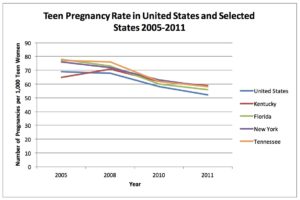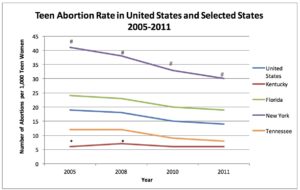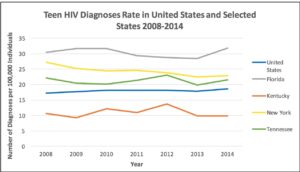Negative Outcomes of Teen Sexual Activity: Is There a Regional Effect?
Hannah Latta1, Said Shahtahmasebi2, Hatim A Omar1
1Department of Pediatrics, Division of Adolescent Medicine and Young Parents Program, University of Kentucky, Lexington, KY. 2Good Life Research Centre Trust, Christchurch, New Zealand.
Corresponding author: Hannah Latta, email: hlla223@g.uky.edu
Keywords: teenage pregnancy, adolescent health, adolescent behaviour
Received: 24/4/2017; Revised: 3/11/2017; Accepted: 10/11/2017
Abstract
A recent victory with respect to teen sexual behavior is the reduction of the national teen birth rate. In 1991, there were 61.8 births per 1000 females aged 15-19. By 2014, this rate plummeted to 24.2 births per 1000 adolescent females. Averages, however, do not reflect state-level variation. For example, in 2014, Kentucky reported 35.3 births per 1000 adolescent females, while New York reported a teen birth rates of 16.1 births per 1000 adolescent females. This report asks: are these discrepancies due to regional factors, and are these differences statistically significant? To examine rural and urban differences in outcomes of teen sexual behavior, data from two rural states (Kentucky and Tennessee) and two urban states (New York and Florida) were analyzed. The results suggest significant differences in teenage sexual behaviour outcomes between and within states. For example, whilst teenage pregnancy rates were similar in all states, abortion rates were significantly lower and birth rates were higher in rural than urban states, suggesting possible differentials in health, social, and economic policies between states.
Introduction
A recent review of the literature (Latta et al.) highlighted a number of negative outcomes of teenage sexual behaviour. These outcomes were identified as teenage/unplanned pregnancy, abortion, sexually transmitted diseases, domestic/peer violence, early termination of education, etc.
An interesting observation from the review was that there were differentials in negative outcomes between regions, e.g. Florida, Kentucky, New York, and Tennessee. A question arises: are these differences real (statistically significant) or just random variation?
The implication is that if the regional differences are statistically significant then it suggests a number of causes which would be of interest to policy makers to identify. For example, the differentials in negative outcomes between regions may well be due to regional policies (e.g. education, social care, public health, health promotion) or regional characteristics (e.g. residential makeup, cultural variations, rurality, socio-economic).
In this paper, we examine regional differences for statistical significance in Florida, Kentucky, New York, and Tennessee.
Methodology
Health statistics in four states (Florida, Kentucky, New York, and Tennessee) were extracted from a number of sources. These data are then analysed to compare and contrast teen health outcomes by region.
Databases used to extract data were: CDC Wonder, University of Wisconsin Population Health Institute County Health Rankings Database, Office of Rural Health Policy, Youth Risk Behavior Surveillance System (YRBSS), Guttmacher Institute, Health Indicators Warehouse (HIW), and the National Center for HIV/AIDS, Viral Hepatitis, STD, and TB Prevention (NCHHSTP) CDC AtlasPlus.
Negative teen health outcomes in each of the four states of interest were compared with the national average, i.e. United States as a whole. Statistical techniques employed included two-sample t-test and chi-square goodness of fit test.
Results
To explore any significant differences in teenage health outcomes due to rurality, Kentucky and Tennessee were classified as rural states, and New York and Florida were classified as urban states (Table 1).
Table 1. Classification of States as Rural or Urban. The Percent Rural Counties statistic for each state was calculated by dividing the number of rural counties by the total number of counties. Rural classification was assigned if the percent population living in rural areas exceeded 50%. (Note: # indicates rural states.) Sources: 1Office of Rural Health Policy; 2County Health Rankings.
| Kentucky# | Tennessee# | New York | Florida | |
| Number of Rural Counties1 | 86 | 53 | 24 | 23 |
| Total Number of Counties | 120 | 95 | 62 | 67 |
| Percent Rural Counties (%) | 71.67 | 55.79 | 38.71 | 34.33 |
| Percent Population Living in Rural Areas2 (%) | 41.60 | 33.60 | 12.10 | 8.80 |
Results suggest differentials in sexual behaviour between states and between states and the nation (Table 2). A main public concern arising from sexual behaviour is unwanted teenage pregnancy. As shown in Figure 1, whilst the trend in teen pregnancy appears downward, it can be observed that states with lower rates of teenage sexual behaviour consistently show a lower rate of teenage pregnancy.
Table 2 – State to Nation Comparisons
Figure 1. Teen Pregnancy Rate in United States and States of Interest: 2005-2011. Displayed above are the mean teen pregnancy rates for the United States, Kentucky, Florida, New York, and Tennessee for the years 2005, 2008, 2010, and 2011. Note: “teen” refers to any young woman aged 15-19; rates for this metric are typically reported per 1,000 teens. Source: Guttmacher Institute

Abortion is an adverse outcome of teenage pregnancy. Quite apart from moral issues it imposes on individuals and society, abortion is a major public health concern with negative impacts on individuals’ physical and mental health and wellbeing. Trends in teenage abortion rates are shown in Figure 2.
Interestingly, rural states (KY and TN) with the highest rate of unsafe sexual behaviour as measured by the question “did not use any method to prevent pregnancy” (Table 2) appear to have the lowest rate of abortion. This suggests differences in behaviour between rural and urban states.
Differentials in behaviour and outcomes may well be influenced by political, social and religious beliefs and attitudes, health and social policies affecting access to care and so on.
A comparison of states provides further evidence of rural-urban differences in outcomes shown in Table 3. For example, the analysis is not statistically significant between the urban states or the rural states, but differentials in teenage abortion rates appear statistically significant when comparing rural with urban states.
Clearly, lower abortion rates will mean higher birth rates. Obviously, health and social policies that discourage prevention and abortion will have significant implications on social and economic policies at the individual and state level. For example, individuals may experience social and physical hardship coming to terms with being a teenage mother/parents, unfulfilled dreams, delayed entry into the labour market, longer dependence on the state, and so on.
Interestingly, teenage behaviour outcomes in rural counties within each state appear to follow the same trends as rural states, e.g. lower abortion and higher birth rates.
Figure 2. Teen Abortion Rate in United States and States of Interest: 2005-2011. Displayed above are the mean teen abortion rates for the United States, Kentucky, Florida, New York, and Tennessee for the years 2005, 2008, 2010, and 2011. Note: “teen” refers to any young woman aged 15-19; rates for this metric are typically reported per 1,000 teens. (* indicates p<0.05 for Kentucky to United States chi-square analysis; # indicates p<0.05 for New York to United States chi-square analysis) Source: Guttmacher Institute

Table 3. Teen Abortion Rates: State-to-State Comparisons for 2005-2011. Displayed below are the teen abortion rates for Kentucky, New York, Florida, and Tennessee for all years of interest: 2005, 2008, 2010, and 2011. Also included are the results of the chi-square analyses conducted for state-to-state comparisons. (Note: *indicates statistically significant result of p<0.05) Source: Guttmacher Institute
| Year | State 1 | State 2 | State 1 Rate | State 2 Rate | P-value |
| 2005 | Kentucky | Florida | 6 | 24 | 0.00* |
| New York | 6 | 41 | 0.00* | ||
| Tennessee | 6 | 12 | 0.16 | ||
| New York | Florida | 41 | 24 | 0.03* | |
| Tennessee | 41 | 12 | 0.00* | ||
| Florida | Tennessee | 24 | 12 | 0.04* | |
| 2008 | Kentucky | Florida | 7 | 23 | 0.00* |
| New York | 7 | 38 | 0.00* | ||
| Tennessee | 7 | 12 | 0.25 | ||
| New York | Florida | 38 | 23 | 0.05 | |
| Tennessee | 38 | 12 | 0.00* | ||
| Florida | Tennessee | 23 | 12 | 0.06 | |
| 2010 | Kentucky | Florida | 6 | 20 | 0.01* |
| New York | 6 | 33 | 0.00* | ||
| Tennessee | 6 | 9 | 0.44 | ||
| New York | Florida | 33 | 20 | 0.07 | |
| Tennessee | 33 | 9 | 0.00* | ||
| Florida | Tennessee | 20 | 9 | 0.04* | |
| 2011 | Kentucky | Florida | 6 | 19 | 0.01* |
| New York | 6 | 30 | 0.00* | ||
| Tennessee | 6 | 8 | 0.59 | ||
| New York | Florida | 30 | 19 | 0.11 | |
| Tennessee | 30 | 8 | 0.00* | ||
| Florida | Tennessee | 19 | 8 | 0.03* |
Another major public health concern is sexually transmitted diseases (STD). Results suggest that rurality does not appear to influence differentials in STD rates between states.
For example, TN has the highest chlamydia and gonorrhea rate whilst FL has the highest syphilis and HIV diagnosis rate. A counterintuitive result from this study is trends for syphilis rates. These trends fluctuate more widely than trends for other STDs, and teenage syphilis rate in FL appears significantly higher than the national average and other states.
Trends for HIV diagnosis in states of NY, TN and FL are higher than the national average, with FL recording highest and KY recording lowest rates (Figure 3).
Figure 3. Teen HIV Diagnoses Rate in United States and States of Interest: 2008-2014. Displayed above are the teen HIV diagnosis rates for the United States, Kentucky, Florida, New York, and Tennessee for the years 2008-2014. Source: NCHHSTP CDC AtlasPlus.

Conclusion
Teen sexual activity has a variety of negative outcomes with adverse health, social, and economic impacts, including pregnancy, birth, STDs, HIV, and sexual violence. The results from this study suggest significant differences in outcomes between rural and urban areas both between states and within states. Whilst some of the differentials, at least in part, can be attributed to region-specific social norms, e.g. beliefs, perceptions and attitudes, there are clear indications that states’ health, social, and economic policies may be playing a significant role. For example, adopting public health policies that are focused on health promotion, prevention, and greater access to services is likely to lead to much fewer unwanted teenage pregnancies and fewer abortions.
The data does not lend itself for a micro-level analysis, i.e. to explore differential in outcomes between the individuals due to socio-economic status, demographic characteristics, beliefs, attitudes and perceptions, and so on. Nevertheless, the analysis of trends that highlights differences in outcomes between states, as reported in this study, can inform the process of policy formation.
References
Centers for Disease Control and Prevention (CDC). NCHHSTP AtlasPlus. Accessed on [27 February 2017]. Available at: https://www.cdc.gov/nchhstp/atlas/
Centers for Disease Control and Prevention (CDC). Sexually Transmitted Disease Surveillance 2015. Atlanta: U.S. Department of Health and Human Services; 2016. Accessed on [27 February 2017]. Available at: https://wonder.cdc.gov/
Centers for Disease Control and Prevention (CDC). [2015] Youth Risk Behavior Survey Data. Available at: www.cdc.gov/yrbs. Accessed on [23 September 2016].
Guttmacher Institute. (2017). Sex and HIV Education. Retrieved from https://www.guttmacher.org/state-policy/explore/sex-and-hiv-education
Guttmacher Institute. (2017). State Facts about Abortion: Kentucky. Retrieved from https://www.guttmacher.org/fact-sheet/state-facts-about-abortion-kentucky#7
Guttmacher Institute. (2017). State Facts about Abortion: New York. Retrieved from https://www.guttmacher.org/fact-sheet/state-facts-about-abortion-kentucky#7
Health Indicators Warehouse (HIW). Births: females 15-19 years (per 1,000). National Center for Health Statistics (2015). Retrieved from https://www.healthindicators.gov/Indicators/Births-females-15-19-years-per-1000_22/Profile
Office of Rural Health Policy. List of Rural Counties and Designated Eligible Census Tracts in Metropolitan Counties (2015). Retrieved from https://www.hrsa.gov/ruralhealth/resources/forhpeligibleareas.pdf
University of Wisconsin Population Health Institute. Kentucky County Health Rankings 2016. Retrieved from http://www.countyhealthrankings.org/app/kentucky/2016/measure/factors/14/map